Leaf Feeders
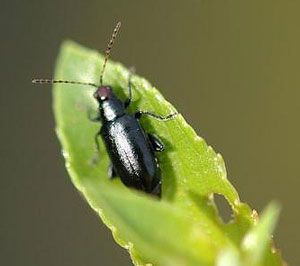
Brian Kunkel, University of Delaware, Bugwood.org
Redheaded flea beetle adults are 1/4 inch long with a black body and red head (but it can be difficult to see). They have large femurs on their back legs that allow them to hop, as the name implies. Larvae are soil-based, have a creamy color and can be up to 1/2 inch long. This pest overwinters as eggs in the soil, and larvae hatch out to feed in the root zone, before pupating to emerge as adults. In Delaware and Maryland this first group of adults emerges when Southern magnolia is in bloom. A second generation occurs later in the summer. Adults feed on leaves causing extensive shot-hole damage.
Sap Feeders
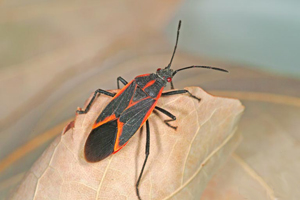
Joseph Berger, Bugwood.org
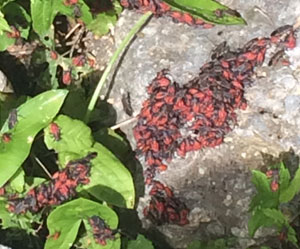
L. Townsend, University of Kentucky
Boxelder bugs are black insects with red or orange markings that feed on sap in developing leaves or seeds; their feeding may result in discolored foliage. However, large numbers of boxelder bugs can develop and become accidental invaders as they move to shelter in cracks and crevices in the fall. They appear to be most abundant during hot, dry summers that follow warm springs.
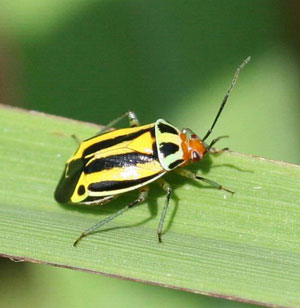
Johnny N. Dell, Bugwood.org
Four-lined plant bug adults are between 1/4-1/3 inch long, have an orange head and yellowish body with four black stripes running down the back. The nymphs are red to red-orange with black dots. There is one generation per year, with feeding and growing occurring in May and June. As they feed, four-lined plant bugs create circular brown-black spots. The spots are about 1/16-inch wide and can merge together to create a blotchy appearance that resembles a disease issue. The damaged spots can also dry and fall out of the surrounding healthy tissue, leaving a hole behind.
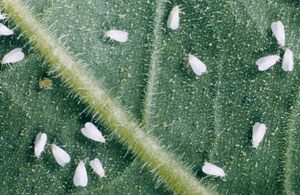
John C. French Sr., Retired, Universities:Auburn, GA, Clemson and U of MO, Bugwood.org
Whiteflies are small (1/16 inch long) insects that live on the leaves of plants but feed on sap. There can be multiple, overlapping generations on a plant but currently whiteflies do not overwinter in Kentucky. They can be reintroduced through infested stock though and do thrive when inside of structures. They begin as hard to find eggs, then become nymphs that are flat and light green, pupate, and become the white winged adults that give them their name. Symptoms of whitefly issues include yellowing of leaves, stunting, dieback, and accumulation of honeydew.
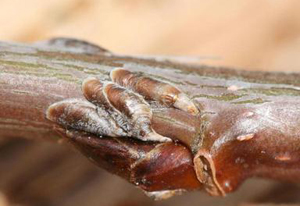
Whitney Cranshaw, Colorado State University, Bugwood.org
Oystershell scales are about 1/10 inch long and resemble crusty accumulations of oyster shells on the bark. Their drab, bark-like appearance makes them easy to overlook, even on close inspection. Heavy infestations can kill twigs or branches. This scale overwinters in the egg stage under the waxy covering of the female. The eggs hatch and the crawlers are active from late May to early June.
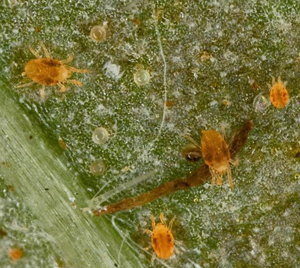
David Cappaert, Bugwood.org
Twospotted spider mites are tiny (1/50 inch) arthropods with a dark spot on each side of the oval, light green to yellow body. They live on the underside of leaves and use needle-like mouthparts to remove the contents of individual cells. This produces tiny white to yellow spots on leaves, sometimes called flecking or bronzing. These mites produce fine silk-like webbing that often covers infested plants. Infestations are usually most serious during hot, dry periods.
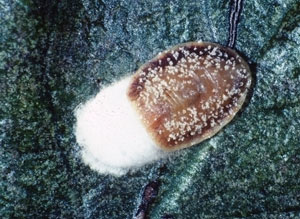
John A. Davidson, Univ. Md, College Pk, Bugwood.org
Cottony camellia scale adult females are about 1/8 inch long but they produce long white egg masses behind them, so they appear much larger. These egg masses are laid on the undersides of leaves and crawlers will hatch and feed throughout the summer. Their feeding results in large quantities of honeydew, which in turn leads to development of black sooty mold.